COMM 6: Intercultural Management Report - Case Study Analysis
VerifiedAdded on 2020/03/07
|6
|1202
|453
Report
AI Summary
This report delves into the complexities of intercultural management within a business context, examining critical issues that arise from cultural differences. The report analyzes a case study, highlighting challenges related to language barriers, communication styles, cultural norms, and team management. It explores how these factors impact business operations, including organizational structures, eating habits, and the roles of women in the workplace. The report emphasizes the importance of understanding and adapting to diverse cultural dimensions for effective management, teamwork, and overall organizational success. Key players such as public and private sectors are involved in intercultural management. The analysis discusses specific cultural dimensions like values, societal structures, and communication methods, concluding that proper cultural management is essential for maximizing organizational output and fostering a culture of prosperity. This report provides valuable insights into navigating intercultural challenges and promoting effective global business practices.
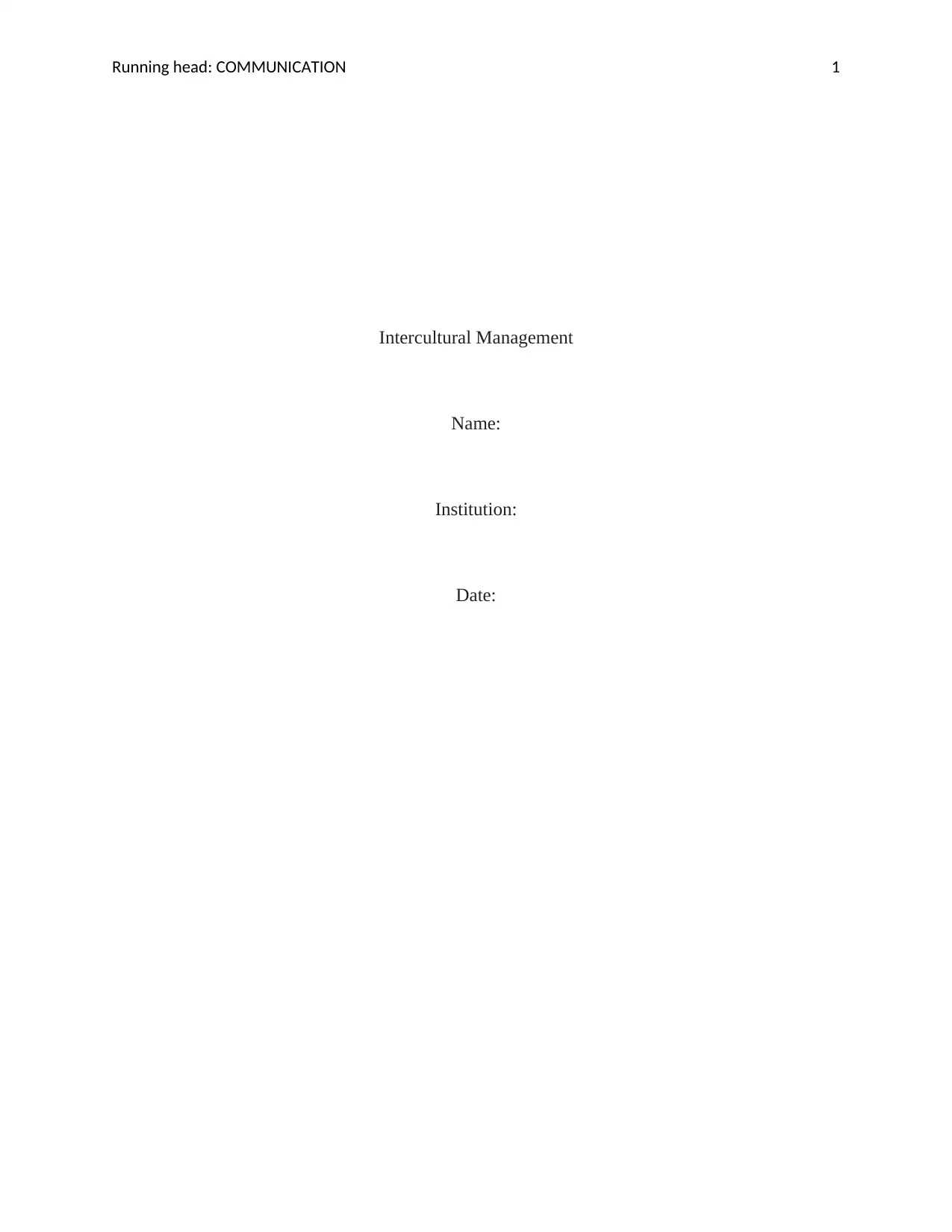
Running head: COMMUNICATION 1
Intercultural Management
Name:
Institution:
Date:
Intercultural Management
Name:
Institution:
Date:
Paraphrase This Document
Need a fresh take? Get an instant paraphrase of this document with our AI Paraphraser
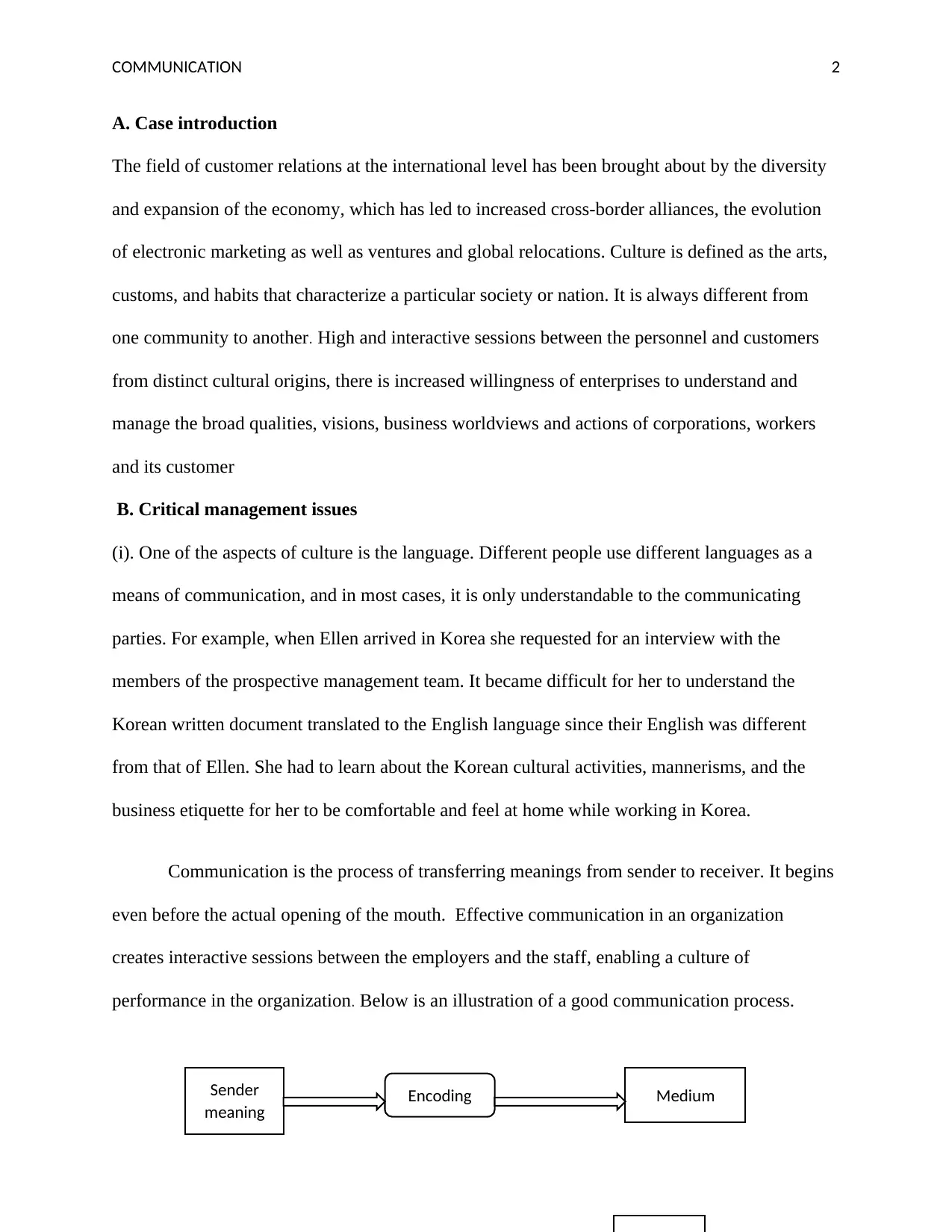
COMMUNICATION 2
A. Case introduction
The field of customer relations at the international level has been brought about by the diversity
and expansion of the economy, which has led to increased cross-border alliances, the evolution
of electronic marketing as well as ventures and global relocations. Culture is defined as the arts,
customs, and habits that characterize a particular society or nation. It is always different from
one community to another. High and interactive sessions between the personnel and customers
from distinct cultural origins, there is increased willingness of enterprises to understand and
manage the broad qualities, visions, business worldviews and actions of corporations, workers
and its customer
B. Critical management issues
(i). One of the aspects of culture is the language. Different people use different languages as a
means of communication, and in most cases, it is only understandable to the communicating
parties. For example, when Ellen arrived in Korea she requested for an interview with the
members of the prospective management team. It became difficult for her to understand the
Korean written document translated to the English language since their English was different
from that of Ellen. She had to learn about the Korean cultural activities, mannerisms, and the
business etiquette for her to be comfortable and feel at home while working in Korea.
Communication is the process of transferring meanings from sender to receiver. It begins
even before the actual opening of the mouth. Effective communication in an organization
creates interactive sessions between the employers and the staff, enabling a culture of
performance in the organization. Below is an illustration of a good communication process.
Sender
meaning Encoding Medium
A. Case introduction
The field of customer relations at the international level has been brought about by the diversity
and expansion of the economy, which has led to increased cross-border alliances, the evolution
of electronic marketing as well as ventures and global relocations. Culture is defined as the arts,
customs, and habits that characterize a particular society or nation. It is always different from
one community to another. High and interactive sessions between the personnel and customers
from distinct cultural origins, there is increased willingness of enterprises to understand and
manage the broad qualities, visions, business worldviews and actions of corporations, workers
and its customer
B. Critical management issues
(i). One of the aspects of culture is the language. Different people use different languages as a
means of communication, and in most cases, it is only understandable to the communicating
parties. For example, when Ellen arrived in Korea she requested for an interview with the
members of the prospective management team. It became difficult for her to understand the
Korean written document translated to the English language since their English was different
from that of Ellen. She had to learn about the Korean cultural activities, mannerisms, and the
business etiquette for her to be comfortable and feel at home while working in Korea.
Communication is the process of transferring meanings from sender to receiver. It begins
even before the actual opening of the mouth. Effective communication in an organization
creates interactive sessions between the employers and the staff, enabling a culture of
performance in the organization. Below is an illustration of a good communication process.
Sender
meaning Encoding Medium
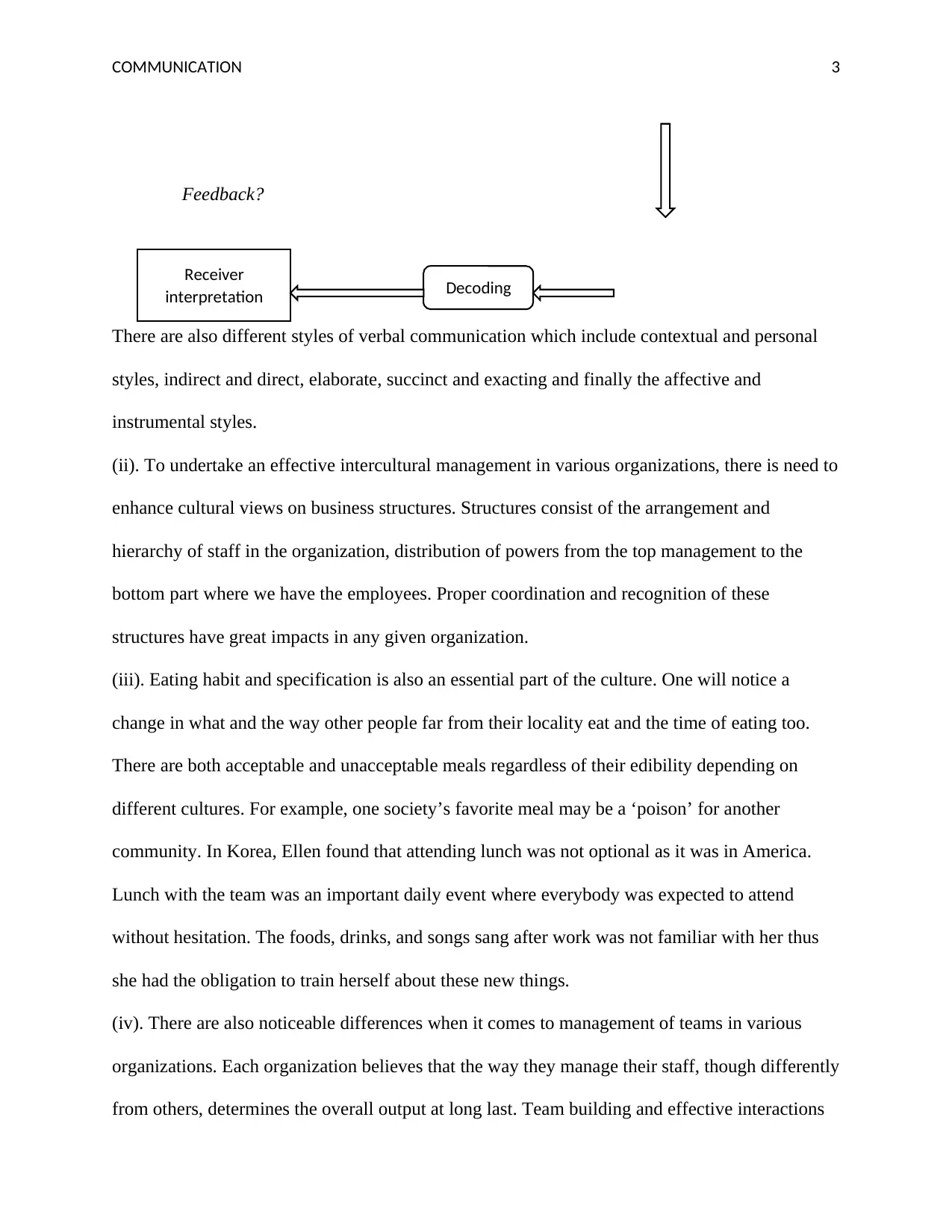
COMMUNICATION 3
Feedback?
There are also different styles of verbal communication which include contextual and personal
styles, indirect and direct, elaborate, succinct and exacting and finally the affective and
instrumental styles.
(ii). To undertake an effective intercultural management in various organizations, there is need to
enhance cultural views on business structures. Structures consist of the arrangement and
hierarchy of staff in the organization, distribution of powers from the top management to the
bottom part where we have the employees. Proper coordination and recognition of these
structures have great impacts in any given organization.
(iii). Eating habit and specification is also an essential part of the culture. One will notice a
change in what and the way other people far from their locality eat and the time of eating too.
There are both acceptable and unacceptable meals regardless of their edibility depending on
different cultures. For example, one society’s favorite meal may be a ‘poison’ for another
community. In Korea, Ellen found that attending lunch was not optional as it was in America.
Lunch with the team was an important daily event where everybody was expected to attend
without hesitation. The foods, drinks, and songs sang after work was not familiar with her thus
she had the obligation to train herself about these new things.
(iv). There are also noticeable differences when it comes to management of teams in various
organizations. Each organization believes that the way they manage their staff, though differently
from others, determines the overall output at long last. Team building and effective interactions
Decoding
Receiver
interpretation
Feedback?
There are also different styles of verbal communication which include contextual and personal
styles, indirect and direct, elaborate, succinct and exacting and finally the affective and
instrumental styles.
(ii). To undertake an effective intercultural management in various organizations, there is need to
enhance cultural views on business structures. Structures consist of the arrangement and
hierarchy of staff in the organization, distribution of powers from the top management to the
bottom part where we have the employees. Proper coordination and recognition of these
structures have great impacts in any given organization.
(iii). Eating habit and specification is also an essential part of the culture. One will notice a
change in what and the way other people far from their locality eat and the time of eating too.
There are both acceptable and unacceptable meals regardless of their edibility depending on
different cultures. For example, one society’s favorite meal may be a ‘poison’ for another
community. In Korea, Ellen found that attending lunch was not optional as it was in America.
Lunch with the team was an important daily event where everybody was expected to attend
without hesitation. The foods, drinks, and songs sang after work was not familiar with her thus
she had the obligation to train herself about these new things.
(iv). There are also noticeable differences when it comes to management of teams in various
organizations. Each organization believes that the way they manage their staff, though differently
from others, determines the overall output at long last. Team building and effective interactions
Decoding
Receiver
interpretation
⊘ This is a preview!⊘
Do you want full access?
Subscribe today to unlock all pages.

Trusted by 1+ million students worldwide
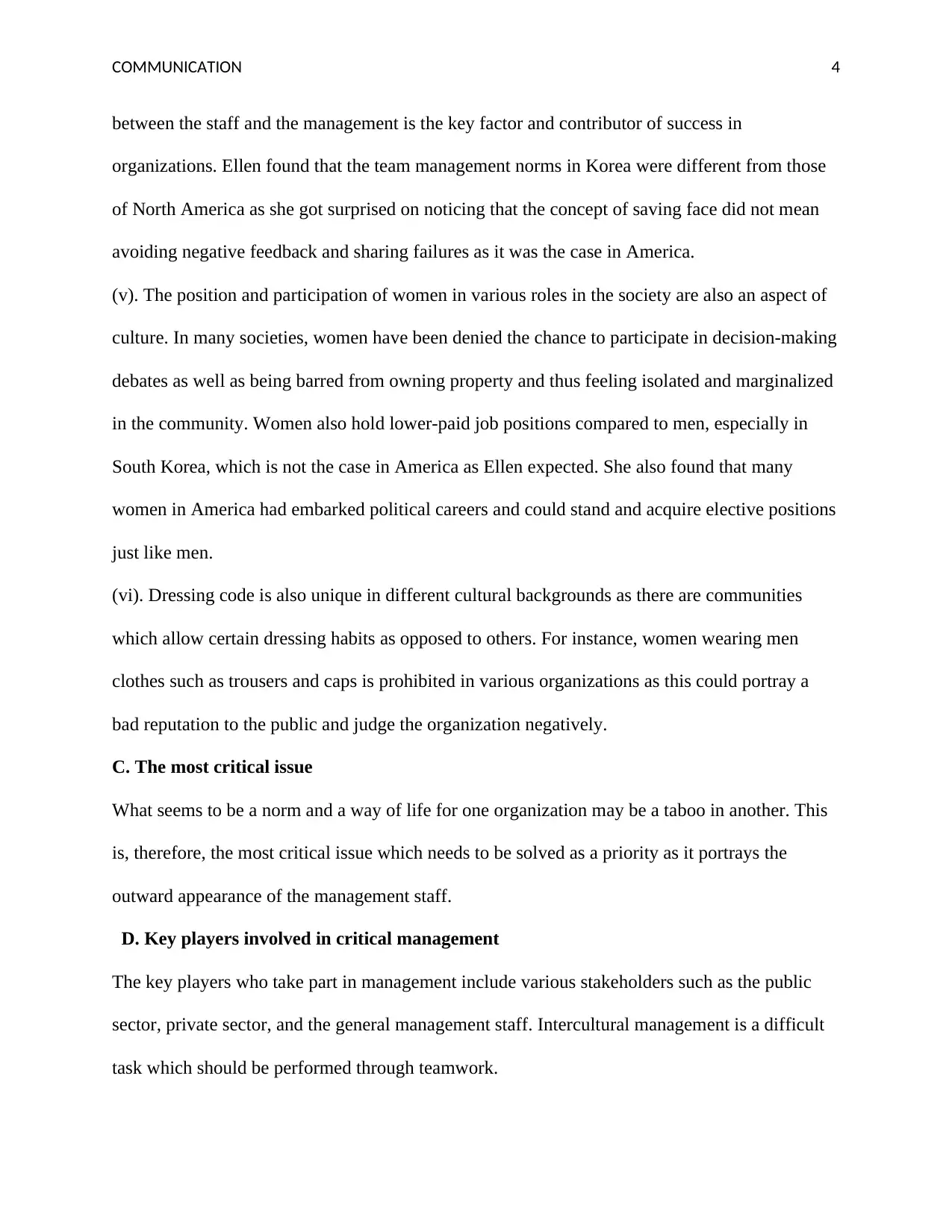
COMMUNICATION 4
between the staff and the management is the key factor and contributor of success in
organizations. Ellen found that the team management norms in Korea were different from those
of North America as she got surprised on noticing that the concept of saving face did not mean
avoiding negative feedback and sharing failures as it was the case in America.
(v). The position and participation of women in various roles in the society are also an aspect of
culture. In many societies, women have been denied the chance to participate in decision-making
debates as well as being barred from owning property and thus feeling isolated and marginalized
in the community. Women also hold lower-paid job positions compared to men, especially in
South Korea, which is not the case in America as Ellen expected. She also found that many
women in America had embarked political careers and could stand and acquire elective positions
just like men.
(vi). Dressing code is also unique in different cultural backgrounds as there are communities
which allow certain dressing habits as opposed to others. For instance, women wearing men
clothes such as trousers and caps is prohibited in various organizations as this could portray a
bad reputation to the public and judge the organization negatively.
C. The most critical issue
What seems to be a norm and a way of life for one organization may be a taboo in another. This
is, therefore, the most critical issue which needs to be solved as a priority as it portrays the
outward appearance of the management staff.
D. Key players involved in critical management
The key players who take part in management include various stakeholders such as the public
sector, private sector, and the general management staff. Intercultural management is a difficult
task which should be performed through teamwork.
between the staff and the management is the key factor and contributor of success in
organizations. Ellen found that the team management norms in Korea were different from those
of North America as she got surprised on noticing that the concept of saving face did not mean
avoiding negative feedback and sharing failures as it was the case in America.
(v). The position and participation of women in various roles in the society are also an aspect of
culture. In many societies, women have been denied the chance to participate in decision-making
debates as well as being barred from owning property and thus feeling isolated and marginalized
in the community. Women also hold lower-paid job positions compared to men, especially in
South Korea, which is not the case in America as Ellen expected. She also found that many
women in America had embarked political careers and could stand and acquire elective positions
just like men.
(vi). Dressing code is also unique in different cultural backgrounds as there are communities
which allow certain dressing habits as opposed to others. For instance, women wearing men
clothes such as trousers and caps is prohibited in various organizations as this could portray a
bad reputation to the public and judge the organization negatively.
C. The most critical issue
What seems to be a norm and a way of life for one organization may be a taboo in another. This
is, therefore, the most critical issue which needs to be solved as a priority as it portrays the
outward appearance of the management staff.
D. Key players involved in critical management
The key players who take part in management include various stakeholders such as the public
sector, private sector, and the general management staff. Intercultural management is a difficult
task which should be performed through teamwork.
Paraphrase This Document
Need a fresh take? Get an instant paraphrase of this document with our AI Paraphraser
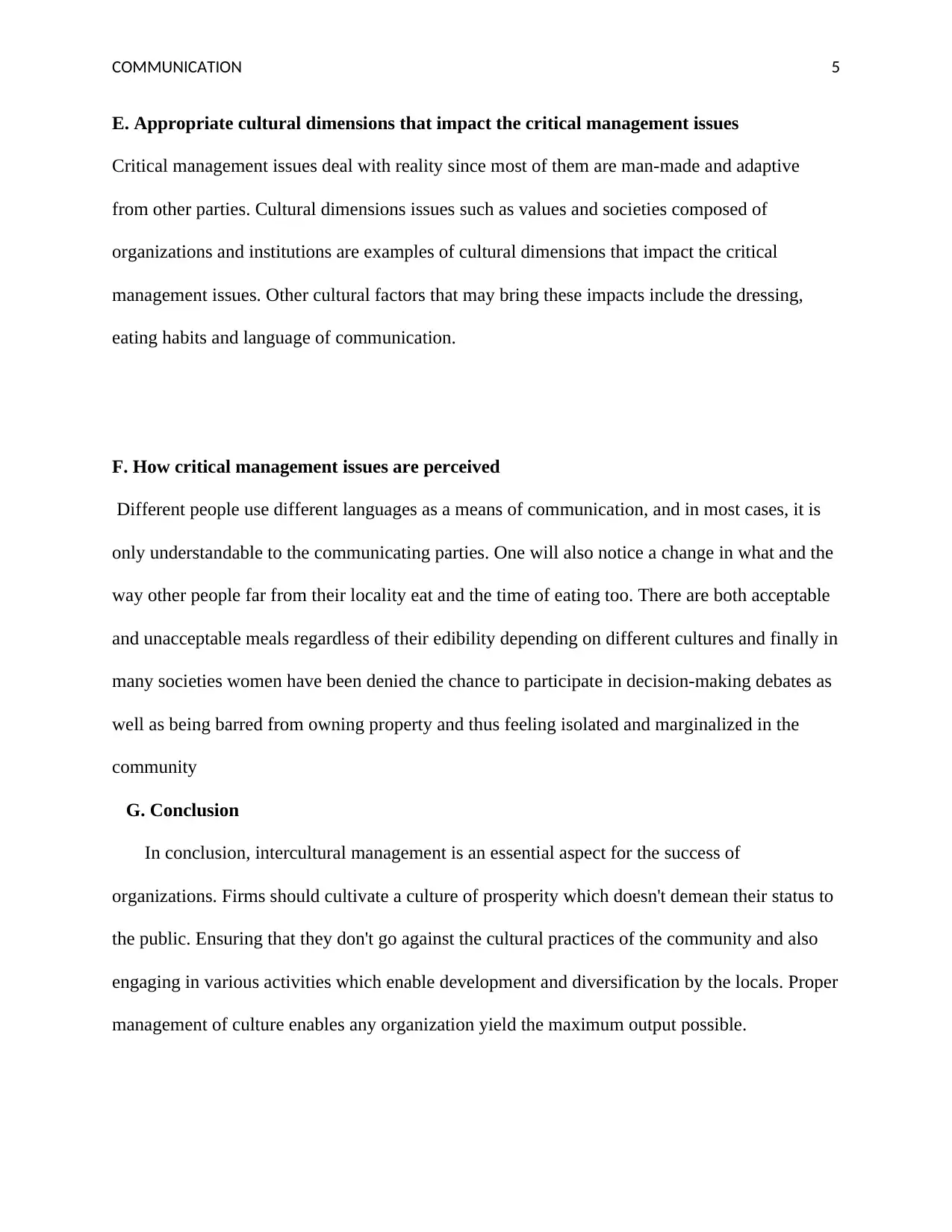
COMMUNICATION 5
E. Appropriate cultural dimensions that impact the critical management issues
Critical management issues deal with reality since most of them are man-made and adaptive
from other parties. Cultural dimensions issues such as values and societies composed of
organizations and institutions are examples of cultural dimensions that impact the critical
management issues. Other cultural factors that may bring these impacts include the dressing,
eating habits and language of communication.
F. How critical management issues are perceived
Different people use different languages as a means of communication, and in most cases, it is
only understandable to the communicating parties. One will also notice a change in what and the
way other people far from their locality eat and the time of eating too. There are both acceptable
and unacceptable meals regardless of their edibility depending on different cultures and finally in
many societies women have been denied the chance to participate in decision-making debates as
well as being barred from owning property and thus feeling isolated and marginalized in the
community
G. Conclusion
In conclusion, intercultural management is an essential aspect for the success of
organizations. Firms should cultivate a culture of prosperity which doesn't demean their status to
the public. Ensuring that they don't go against the cultural practices of the community and also
engaging in various activities which enable development and diversification by the locals. Proper
management of culture enables any organization yield the maximum output possible.
E. Appropriate cultural dimensions that impact the critical management issues
Critical management issues deal with reality since most of them are man-made and adaptive
from other parties. Cultural dimensions issues such as values and societies composed of
organizations and institutions are examples of cultural dimensions that impact the critical
management issues. Other cultural factors that may bring these impacts include the dressing,
eating habits and language of communication.
F. How critical management issues are perceived
Different people use different languages as a means of communication, and in most cases, it is
only understandable to the communicating parties. One will also notice a change in what and the
way other people far from their locality eat and the time of eating too. There are both acceptable
and unacceptable meals regardless of their edibility depending on different cultures and finally in
many societies women have been denied the chance to participate in decision-making debates as
well as being barred from owning property and thus feeling isolated and marginalized in the
community
G. Conclusion
In conclusion, intercultural management is an essential aspect for the success of
organizations. Firms should cultivate a culture of prosperity which doesn't demean their status to
the public. Ensuring that they don't go against the cultural practices of the community and also
engaging in various activities which enable development and diversification by the locals. Proper
management of culture enables any organization yield the maximum output possible.

COMMUNICATION 6
⊘ This is a preview!⊘
Do you want full access?
Subscribe today to unlock all pages.

Trusted by 1+ million students worldwide
1 out of 6
Your All-in-One AI-Powered Toolkit for Academic Success.
+13062052269
info@desklib.com
Available 24*7 on WhatsApp / Email
![[object Object]](/_next/static/media/star-bottom.7253800d.svg)
Unlock your academic potential
Copyright © 2020–2025 A2Z Services. All Rights Reserved. Developed and managed by ZUCOL.


